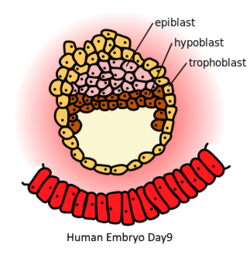Epiblast
| Epiblast | |
|---|---|
 Human embryo at day 9. Epiblast (pink) is on top of the hypoblast (brown) | |
| Details | |
| Carnegie stage | 3 |
| Days | 8 |
| Precursor | inner cell mass |
| Gives rise to | ectoderm, mesoderm, endoderm |
| Identifiers | |
| Latin | epiblastus |
| TE | E5.0.2.2.1.0.1 |
| Anatomical terminology | |
In
The other layer of the inner cell mass, the hypoblast, gives rise to the yolk sac, which in turn gives rise to the chorion.
Discovery of the epiblast
The epiblast was first discovered by
Mammals
In
In the mouse, primordial germ cells are specified from epiblast cells.[4] This specification is accompanied by extensive epigenetic reprogramming that involves global DNA demethylation, chromatin reorganization and imprint erasure leading to totipotency.[4] The DNA base excision repair pathway has a central role in the process of genome-wide demethylation.[5]
Upon commencement of
During gastrulation, migrating epiblast cells undergo

Epiblast diversity
Epiblasts exhibit diverse structure across species as a result of early embryo morphogenesis. The human epiblast assumes a disc shape, conforming to the embryonic disc morphology; whereas, the mouse epiblast develops in a cup shape within the cylindrical embryo.
During implantation of the blastocyst, both the human and mouse epiblasts form a rosette shape in a process called polarization. Polarization results from the interaction between the mammalian blastocyst and β1-integrin from the extracellular matrix, produced from the extra-embryonic tissues.[7] At this stage, both human and mouse epiblasts consist of a pseudostratified columnar epithelium. Shortly after, the human epiblast will assume a disc shape while the amniotic cavity forms. The epiblast cells adjacent to the trophoblast are specified to become amnion cells. The mouse epiblast transitions from a rosette structure to a cup. A pro-amniotic cavity forms, surrounded by the epiblast cup fused to extraembryonic ectoderm. Mouse epiblast cells are not specified to amnion cell fate. [8]
Birds
Gastrulation occurs in the epiblast of avian embryos. A local thickening of the epiblast, known as Koller's sickle, is key in inducing the primitive streak, the structure through which gastrulation occurs.[9]
Studies on chick embryos have shown that
Reptiles
Ancestors of
See also
- Embryogenesis
- Human embryogenesis
- Hypoblast
References
- ^ Wessel, G. M. (2010). Christian Heinrich Pander (1794–1865). Molecular Reproduction and Development, 77(9).
- ^ Gilbert SF, editor. A Conceptual History of Modern Embryology: Volume 7: A Conceptual History of Modern Embryology. Springer Science & Business Media; 2013 Nov 11.
- ^ Gilbert SF, editor. A Conceptual History of Modern Embryology: Volume 7: A Conceptual History of Modern Embryology. Springer Science & Business Media; 2013 Nov 11.
- ^ PMID 23223451.
- PMID 20595612.
- ^ Shen MM. Nodal signaling: developmental roles and regulation. Development 2007; 134(6): 1023-1034.
- PMID 12737798.
- S2CID 49908419.
- ^ Gilbert SF. Developmental Biology. 10th edition. Sunderland (MA): Sinauer Associates; 2014. Early Development in Birds. Print
- S2CID 4391134.
- S2CID 20650158.
